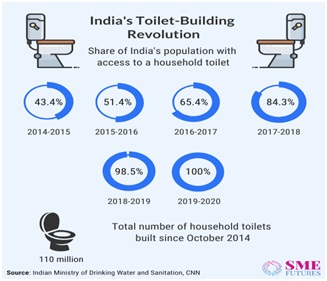India responsible for largest drop in open defecation since 2015: WASH report
- Posted By
10Pointer
- Categories
Polity & Governance
- Published
7th Jul, 2021
-
-
Context
India was responsible for the largest drop in open defecation since 2015, in terms of absolute numbers, according to a new report by the Wash Institute, a global non-profit organization.
-
What are the major findings in the Report?
- Within India, open defecation had been highly variable regionally since at least 2006.
- NFHS3: In 2006, the third round of the National Family Health Survey (NFHS) found open defecation to be practiced by less than 10 per cent of the population in four states and the Union Territory of Delhi, but by more than half the population in 11 states.
- NFHS4: By 2016, when the fourth round of the NFHS was conducted, open defecation had decreased in all states, with the largest drops seen in Himachal Pradesh and Haryana.
|
Other highlights
- Onsite sanitation system, a system in which excreta and wastewater are collected, stored and / or treated on the plot where they are generated had shown a significant global increase.
- Globally, access to safely managed sanitation services increased over the 2000-2020 period by an average of 1.27 percentage points per year.
|
-
What is the progress on SDG 6?
- Access to safely managed drinking water: Between 2016 and 2020, the global population with access to safely managed drinking water at home increased to 74 per cent, from 70 per cent.
- At-source water resources: There is improvement in at-source water resources including piped water, boreholes or tubewells, protected dug wells, protected springs, rainwater and packaged or delivered water.
- There was an increase in safely managed sanitation services to 54 per cent, from 47 per cent between 2016 and 2020.
|
SDG 6 states that ensuring availability and sustainable management of water and sanitation for all by 2030 entails that water must be accessible at source, available when needed and free from any contamination.
|
-
How water is categorized for monitoring?
- Accessible on premises: Water sources are considered ‘accessible on premises’ if the point of water collection is within the dwelling, compound, yard or plot, or is supplied to the household through piped supply or tanks.
- Available when needed: Water is counted as ‘available when needed’ if households report having ‘sufficient’ water.
- Free from contamination: For the purposes of global monitoring, drinking water is considered ‘free from contamination’ if the water is free and safe from contamination of bacteria like E coli.
- The first five-year plan that Nehru government formulated for the duration 1951-1956 argued for higher allocation in public health.
- In 1954, the first Rural Sanitation Programme was introduced.
|
-
What does the Government data say?
- In theory, in October 2019, five years after the launch of the Centre's flagship Swachh Bharat Mission (SBM), Prime Minister Narendra Modi declared Indian 100% ODF, meaning every household in the country has access to a toilet.
- In 2014, only 43.4 % of households had a toilet.

-
Why open defecation is a serious issue?
- High death rate: Globally, around 2.4 million deaths occur each year due to lack of hygiene, sanitation and water. According to UNICEF, India had the highest number of people in the world -- about 620 million -- who defecated in the open, with the vast majority in rural areas.
- Health hazard: Open defecation is a major public health hazard, especially for children who risk catching potentially deadly diseases like diarrhea and enteric parasite infection.
- Child mortality: Fecal contamination and poor sanitation is a leading cause of child mortality, disease, under nutrition and stunting.
- Water contamination: Open defecation contaminates sources of drinking water.
- Threat to women safety: Open defecation also exposes women and girls to the danger of physical attacks and rape, and they often have to wait until dark to relieve themselves.
-
Central Government Initiatives for Urban Water and Sanitation
|
Initiatives
|
Objectives
|
|
Jawaharlal Nehru National Urban Renewal Mission (JNNURM)
|
Urban infrastructure, water supply, drainage
|
|
Ministry of Urban Development – High Powered Expert Committee, 2008
|
|
12th Five Year Plan Committee
|
|
Ministry of Urban Development – Advisory Note on Improving Water Supply and Sanitation Services, 2012
|
Development of water supply and sanitation, operationalising business plans, service improvement plan, capacity building, reducing leakages in water supply and re-use of water.
|
|
National Water Policy 2012
|
|
MoUD and MoHUPA Centres of Excellence and National Resource Centre
|
|
Steering Committee on Drinking Water Supply and Sanitation, Planning Commission, GOI, 2002
|
Levy of water charges for maintenance and future improvement schemes, supply of healthy drinking water.
|
|
Swachch Bharat Mission
|
Healthy sanitation practices, awareness and behavioral change in people with regard to urban water and sanitation, waste management and drainage, private sector participation.
|
|
National Urban Sanitation Policy
|
|
Service Level Benchmarking Initiative
|
|
National Sanitation Ratings of Cities
|
|
Central Public Health and Environmental Engineering Organization Manuals
|
|
Septage Management Advisory
|
|
Advisory on Water and Sanitation Services
|
|
Hand Hygiene for All initiative
- In June 2020, the World Health Organization and UNICEF jointly launched the ‘Hand Hygiene for All’ initiative.
- It aims to improve access to handwashing infrastructure as well as stimulating changes in handwashing practices where facilities are available.
|
-
Conclusion
The overall situation has improved. However, in order to ensure long-term sustainability of both centralized and decentralized sanitation, proper funding and investment was required.
